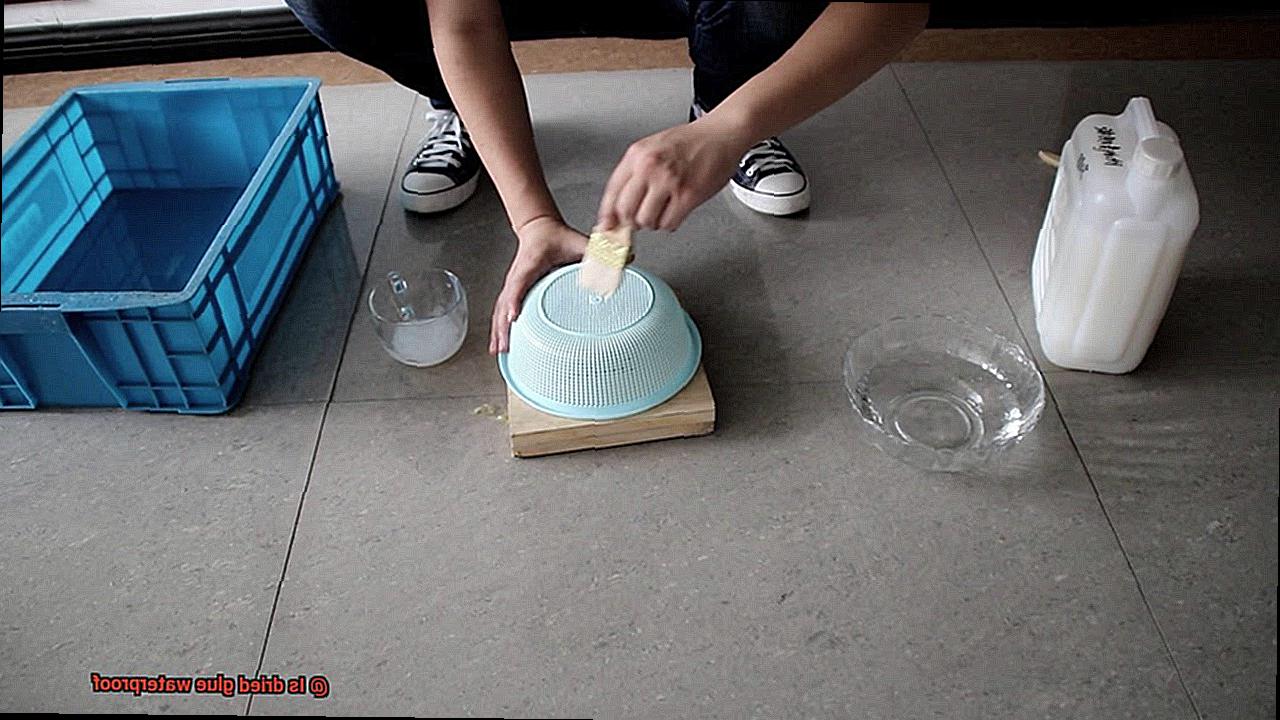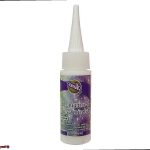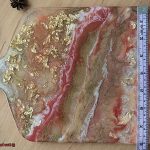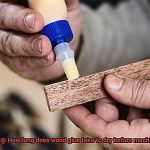Have you ever stopped to ponder if dried glue can really stand up to water? Maybe you’ve applied it to fix a leaky roof or repair your rain boots, and now you’re curious if your DIY project will survive a downpour. Or perhaps you’re an artist who’s frequently asked whether your glue-bound masterpiece will survive a spill or splash. Whatever your motivation, the question of whether dried glue is waterproof is intriguing and multi-faceted.
On one hand, some adhesives are marketed as “waterproof” or “water-resistant,” suggesting that they can endure exposure to moisture without losing their adhesive properties. However, the term “waterproof” is often subjective and can depend on factors such as the surface being glued, the temperature and humidity of the environment, and the amount of stress the bond will encounter.
So what’s the truth about dried glue and its ability to withstand water? In this blog post, we’ll delve into the science behind adhesives and waterproofing, explore different types of glue and their potential for water resistance, and provide some tips and tricks for achieving a water-resistant bond. By the end of this post, you’ll be well-equipped to determine whether your dried glue can hold up against nature’s elements and select the right adhesive for your next project.
What is Dried Glue?
Contents
That’s dried glue. It’s a magical adhesive that comes in various forms and textures, from hard and brittle to flexible and rubbery. But what makes it different from regular glue?
Dried glue is simply glue that has been left to dry. It’s commonly used in arts and crafts, woodworking, or in industrial settings. Once the glue dries, it solidifies and forms a bond between the surfaces it was applied to.
It’s important to note that not all dried glue is created equal. Different types of glue have different properties that affect how well they hold up over time. For example, waterproof adhesives like polyurethane and epoxy are perfect for water-sensitive projects whereas white or school glue are not designed to be waterproof and will break down when exposed to moisture.
When glue dries, it can take on different textures and forms depending on the type of glue used. Some glues dry hard and brittle, while others remain somewhat flexible. Some may dry clear or transparent, while others may dry opaque or with a yellowish tint.
There are some factors that affect how well dried glue works too. The conditions under which the glue was dried can also impact its effectiveness. If the glue was exposed to moisture while drying, it may not adhere as well as if it had dried in a dry environment.
Types of Dried Glue
When it comes to dried glue, there are several types available in the market, and each has its own unique properties, especially when it comes to waterproofing. In this article, we will delve into the different types of dried glue and their waterproofing abilities.
First on our list is PVA (polyvinyl acetate) glue. This water-based adhesive dries clear and has good waterproofing properties. However, it may not be ideal for use in areas with high humidity or exposure to water for extended periods. So, while it’s excellent for indoor projects, it may not hold up well in damp or wet environments.
Next up is epoxy glue, a two-part adhesive that provides excellent waterproofing properties. When mixed together, it creates a robust bond that can withstand exposure to water and is perfect for marine environments. It’s no wonder that epoxy glue is often used to repair boats and other watercraft.
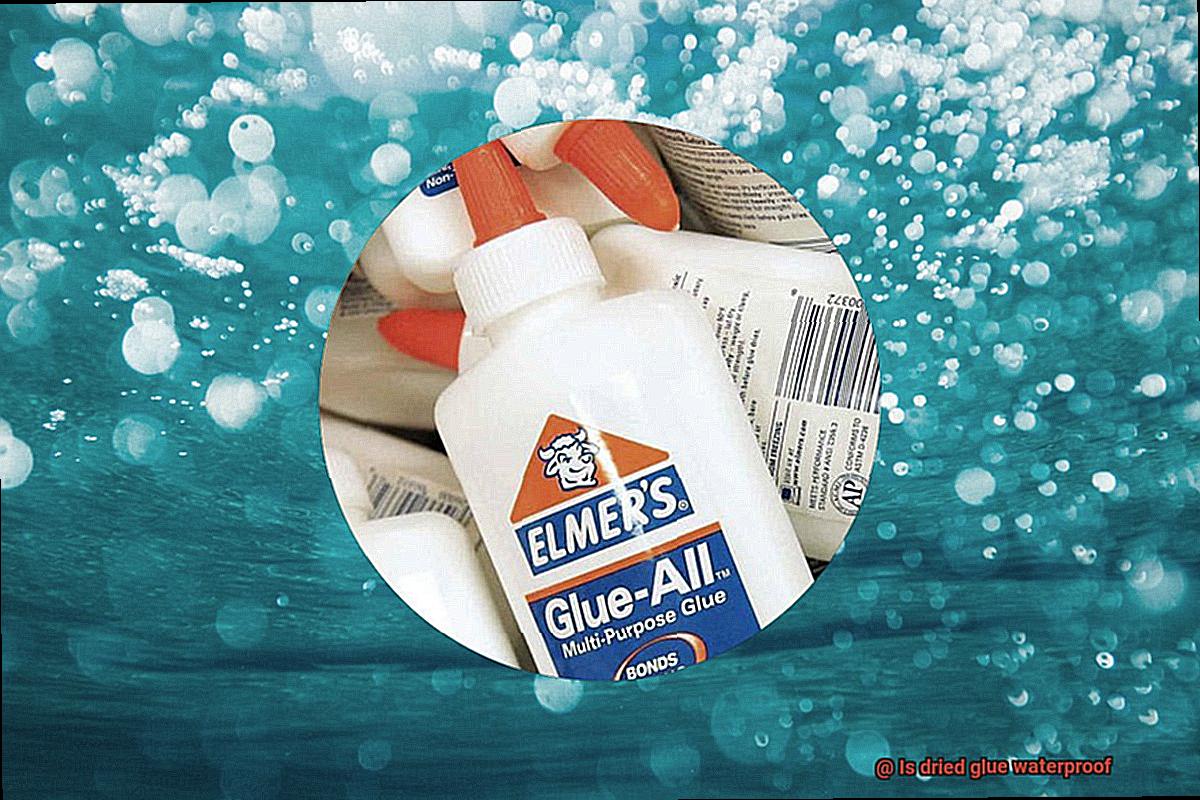
Cyanoacrylate glue, also known as superglue, is a fast-drying adhesive that forms a strong bond. However, it may not be suitable for use in wet environments as it can break down when exposed to water. So, while it’s perfect for quick fixes and small projects, it’s not the best option for anything that may get wet.
Last but not least, hot glue is another popular type of dried glue that can provide some level of waterproofing depending on the materials being bonded. It’s ideal for use in crafts and projects but may not be the best option for outdoor use or areas with high exposure to water.
Is Dried Glue Waterproof?
The answer to this question isn’t straightforward since it depends on the type of glue used.
One type of glue that boasts waterproof properties is PVA or polyvinyl acetate glue. This adhesive is popular in woodworking and crafting because it forms a robust bond that is resistant to moisture. Once PVA glue has dried, it becomes waterproof, making it ideal for projects that will be exposed to water.
Another highly water-resistant glue is epoxy resin. This two-part adhesive is incredibly strong and durable, making it perfect for marine applications. When dried, epoxy resin forms a bond that is not only waterproof but also heat-resistant.
However, not all types of glue are waterproof when they dry. Hot glue and cyanoacrylate (super glue) are susceptible to water damage once they’ve dried. This means that items bonded together with these types of glue may weaken or come apart if exposed to moisture.
To ensure your project’s longevity, it’s crucial to choose the right glue for the job. If you’re working on a project that will be exposed to moisture, then using PVA glue or epoxy resin would be an excellent choice. On the other hand, if you’re working on a project that won’t be exposed to water, then hot glue or cyanoacrylate glue might be a better option.
Factors Affecting the Waterproofness of Dried Glue
When it comes to creating waterproof projects, selecting the right type of glue is vital. While certain adhesives like epoxy and cyanoacrylate are naturally more waterproof than others like PVA glue, other factors can also impact the waterproofness of dried glue.
One such factor is the application method. If the glue is applied too thinly or unevenly, it may not create a robust enough bond to withstand exposure to water. Similarly, if the adhesive is used in an area subjected to significant movement or stress, like a joint or seam, it may struggle to maintain its waterproof properties over time.
Environmental conditions also play a significant role. Extreme temperatures, humidity, or UV light can weaken the bond of dried glue and compromise its ability to resist water. Additionally, exposure to chemicals or solvents can break down the adhesive’s structure and make it more vulnerable to water damage.
The quality of materials being bonded also affects the waterproofness of dried glue. Materials that are porous or absorbent, such as wood or fabric, may be more prone to water damage even if the glue itself is waterproof. On the other hand, non-porous materials like metal or plastic are less likely to be damaged by water, regardless of the type of glue used.
How to Make Dried Glue Waterproof
In this blog post, we will explore five different methods for making dried glue waterproof, ensuring your projects stay in top condition even in wet conditions.
Method 1: Apply a Waterproof Sealant
One of the simplest ways to waterproof dried glue is by applying a coat of waterproof sealant. This can be done using products such as polyurethane or silicone sealant. Applying the sealant is easy, just ensure the entire surface area is covered and leave it to dry for the recommended amount of time. Once dry, your item will be ready for use in water.
Method 2: Use a Waterproof Glue
Using a waterproof glue from the outset is another option. There are many types of waterproof glue available on the market, such as marine-grade adhesive or waterproof epoxy. These types of glues are designed specifically to withstand exposure to water and moisture, making them perfect for projects that will be used in wet conditions.
Method 3: Add a Waterproofing Agent
If you have already used a non-waterproof glue and need to make it waterproof after the fact, you can try adding a waterproofing agent to the glue. Popular options include adding silicone or acrylic caulk to create a waterproof barrier.
Method 4: Mix in Silicone
Silicone is a highly resistant material that can be mixed into glue as a waterproofing agent. It can also be purchased pre-made as silicone glue that already contains the waterproofing agent. When mixing silicone into glue, ensure it is thoroughly mixed before it dries so that the waterproofing agent is evenly distributed throughout the glue.
Method 5: Apply a Waterproof Coating
Applying a waterproof coating over dried glue is another option. This can be done using products like clear sealant sprays, varnishes, or even nail polish. Ensure the dried glue is completely dry and free from any dust or debris before applying the coating to guarantee adhesion.
Remember to always check the label of your glue to see if it is suitable for use in water or damp environments. If in doubt, opt for a specifically designed waterproof glue or sealant instead. By applying these methods to protect your glued items from water damage, you can ensure they last longer and stay looking their best.
qkurz6sEuRU” >
Also Read: Is Elmer’s Glue Waterproof?
Conclusion
In summary, determining whether dried glue is waterproof can be a complex matter. The answer hinges on a variety of factors, including the type of adhesive used, environmental conditions, and the quality of materials being bonded. But fear not. By delving into the science behind adhesives and waterproofing, you can make informed decisions about which glue to use for your next project.
If you’re looking for top-tier water resistance in your dried glue, consider polyvinyl acetate (PVA) glue or epoxy resin. However, hot glue and cyanoacrylate (super glue) may not hold up as well when exposed to moisture.
To keep your project watertight, it’s important to select the right type of adhesive for the job and apply it with precision. You can also try applying a waterproof sealant or adding a waterproofing agent to boost your dried glue’s resistance to water damage.
With these strategies in mind, you’ll be able to create sturdy and long-lasting projects that won’t lose their adhesive properties even when faced with water exposure.

